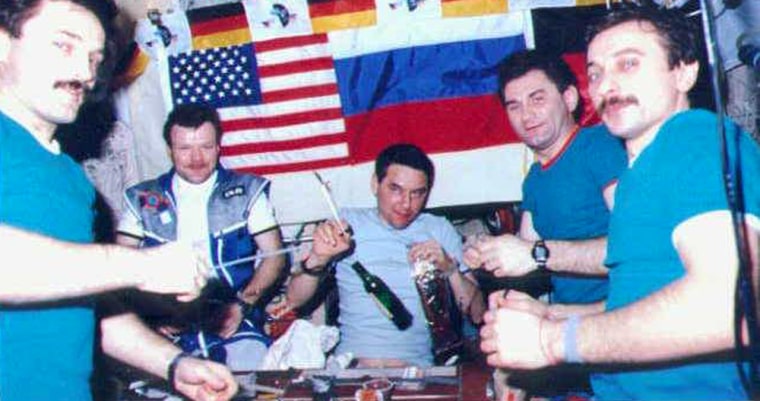A retired cosmonaut says Russian doctors have sent alcoholic beverages along with spacefliers for years to keep them "in tone" and neutralize tension.
This week's comments from Alexander Lazutkin, who lived aboard Russia's Mir space station during one of the tensest episodes in space history, confirm what most observers have long known about Moscow's space effort. The Russians have looser standards than NASA when it comes to drinking alcohol in orbit — and if there's cognac or vodka aboard the International Space Station, they've been able to hide it pretty well.
It was a different story on Mir, however. There, the Americans were guests, and stood by while their Russian colleagues imbibed the occasional stress-reliever or New Year's toast. (Click over to this archived item and scroll down to "Do Astronauts and Alcohol Mix?" for further background.)
On Monday, Lazutkin discussed the history of drinking in space with journalists at Moscow's Memorial Museum of Cosmonautics, where he's the deputy director. "During prolonged space missions, especially at the beginning of the Space Age, we had alcoholic drinks in the cosmonauts' rations," the Interfax news agency quoted him as saying Monday. "This was cognac, which the doctors recommended for use. We used it to stimulate our immune system and on the whole to keep our organisms in tone."
Later, a type of ginseng liqueur (literally, "liqueur from the eleutherococcus") was occasionally consumed, he said.
During Lazutkin's stint aboard Mir in 1997, an unpiloted supply vehicle collided with one of the space station's modules, opening up a leak that almost forced an emergency evacuation. Lazutkin said he and his crewmates definitely opened the liquor cabinet after that incident.
"Yes, we resorted to alcohol during our flight. But this was by authorization of the Ministry of Public Health," he said. RIA Novosti quoted Lazutkin as saying that alcohol was "recommended for neutralizing the harmful effect of the atmosphere" — though it's not clear whether he was referring to the air or the working conditions.
NASA says its astronauts have not used alcohol in space, although the agency found itself in the middle of a controversy back in 2007 when an independent panel passed along concerns about pre-flight drinking. At the time, NASA said it was not able to confirm any flight risks linked to alcohol consumption. Since then, NASA has tightened up its policies on alcohol and drug use even more. Such prudishness may well leave Russian doctors, and Lazutkin as well, shaking their heads.
"How can you greet the New Year without champagne?" Lazutkin asked.
The reason for Lazutkin's session with reporters was not to discuss the cosmonauts' drinking habits, but to announce the winner of a passenger ticket on Armadillo Aerospace's suborbital spacecraft, arranged through the Virginia-based Space Adventures travel company. Evgeny Kovalev of St. Petersburg won the ticket in a contest sponsored by the Efes brewery, and became Armadillo's first confirmed passenger.
Space Adventures' Russian representative, Sergei Kostenko, said the current plan called for Armadillo's craft to have its first piloted test flight in 2012. Passengers would be put on board after five or six additional test flights, he was quoted as saying in a RIA Novosti report. He also said about 200 applicants are on the list for the $102,000-per-person space tour packages.
So will Kovalev and other suborbital spacefliers be sipping cognac to celebrate flying on Armadillo's spaceship? Don't count on it.
"No alcoholic drinks will be consumed during the Armadillo Aerospace/Space Adventures’ suborbital spaceflights," Stacey Tearne, Space Adventures' vice president for communication, told me in an e-mail.
Would you go along with having a no-alcohol policy for spaceflight, or would you agree with Lazutkin that there'd be little harm in drinking a slightly intoxicating toast while you're taking your six-figure ride into space? Feel free to weigh in with your comments below.
Update for 2:30 p.m. ET Oct. 15: NBC News space analyst James Oberg sends along this photographic footnote:
"A delicious backstory to this article is how the lead photo of the medicinal cognac party ever reached the public. When Jerry Linenger returned from Mir in mid-1997, his photographs were processed into the NASA internal archive system, and I became aware of the scene (one of two shots) by means I still need to protect. But when I formally requested a copy for publication, from the NASA Public Affairs Office, the request was denied — reportedly on direct orders from astronaut Frank Culbertson, then the head of NASA's Shuttle-Mir office while angling for a future spaceflight of his own (which he did get, on ISS, in 2001). But my subsequent formal request via the Freedom of Information Act eventually shook the photos free — only because I was able to cite the exact photo ID numbers [if I hadn't originally known the photos existed, I doubt they'd ever have been released]. I used the photo in my 2002 book "Star-Crossed Orbits," and provided this particular image to MSNBC as well. I'm not sure the photo is even yet available to the general public on NASA's website — can anybody check?"
Connect with the Cosmic Log community by "liking" the log's Facebook page or following @b0yle on Twitter. You can also check out "The Case for Pluto," Alan's book about the controversial dwarf planet and the search for new worlds.
